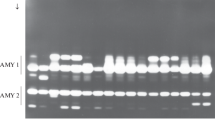Abstract
The inheritance of gramine indole alkaloid was studied in F1 and F2 generations derived from crosses between wild ( Hordeum vulgare subsp. spontaneum) and cultivated ( H. vulgare subsp. vulgare) barley at adult stage in the field. The means of gramine content were very low in F1s and F2s in April and May. The ratio of progeny containing gramine to those without gramine (near zero or undetectable) fit a mono-genic or di-genic model in F2 generation. However, the content of gramine might be controlled by minor genes in the gramine-containing plants. The direction of dominance was toward lower gramine content. The averages of dominance ( h/d) in F1 and F2 ranged from partial to complete. Broad-sense heritabilities were high (0.70 to 0.77). The usefulness of hybrids for breeding aphid resistance and possibility increasing palatability of grazing pasture for sheep and cattle is discussed.
Similar content being viewed by others
References
Baker, R.E. & A.W. Hovin, 1974. Inheritance indole alkaloids in reed canary grass (Phalaris arundinacea L.). I. Heritability estimates for alkaloid concentration. Crop Sci 14: 50–54.
Brandt, K., H. von Euler, H. Hellstrom & N. Lofgren, 1935. Gramin und zwei Begleiter desselben in laubblattern von Gerstensorten. Z Pysiol Chem 235: 37–42.
Breccia, A. & L. Marion, 1959. The biogenesis of alkaloids. XXII. Some intermediate steps in the transformation of tryptophan to gramine. Can J Chem 37: 1066–1070.
Corcuera, L.J., 1993. Biochemical basis of the resistance of the barley to aphids. A review article number 78. Phytochemistry 33: 741–747.
Coulman, B.E., D.L. Woods & K.W. Clark, 1976. Identification of low alkaloid genotypes of reed canary grass. Can J Plant Sci 56: 837–845.
Coulman, B.E., D.L. Woods & K.W. Clark, 1977. Distribution within the plant variation with maturity and heritability of gramine and holdenin in reed canary grass. Can J Plant Sci 57: 771–777.
Falconer, D.S., 1996. Introduction to Quantitative Genetics, 3rd edition Longman.
Gross, D., H. Lehmann & H.R. Schutte, 1974. Zur boisynthese des gramins. Biochem Physiol Pflanzen 166: 281–287.
Hanson, A.D., K.M. Ditz, G.W. Singletary & T. J. Leland, 1983. Gramine accumulation in leaves of barley grown under high temperature stress. Plant Physiol 71: 896–904.
Hanson, A.D., P.L. Traynor, K.M. Ditz & D.A. Reicosky, 1981. Gramine in barley forage. Effects of genotype and environment. Crop Sci 21: 726–730.
Hovin, A.W., 1979. Breeding to reduce antinutritional constituents in forage grasses. Biuletyn Instytutu Hodovli i Aklimatyzacji Roslin 135 (Suppl. 1): 249–263.
Kanehisa, K., H. Tsumuki, K. Kawada & M.A. Rustamani, 1990. Relations of gramine contents and aphid populations on barley lines. Appl Entomol Zool 25: 251–259.
Kanehisa, K., M.A. Rustamani, H. Tsumuki, T. Kasahara & T. Shiraga, 1993. Changes of gramine contents as an aphid resistant substance with barley growth. Bull Res Inst Bioresour, Okayama Univ. 1: 105–112 (in Japanese with an English summary).
Leland, T.J., R. Grumet & A.D. Hanson, 1985. Biochemical, immunological and genetic characterization of natural gramine-free variants of Hordeum vulgare L. Plant Sci 42: 77–82.
Marten, G.C., 1973. Alkaloids in reed canary grass. In: A.G. Matches, R.W. Howell, D.A. Fuccillo & L.H. Paskin (eds), Antiquality components of forages, pp. 15–31. Spec Publ 4. Crop Sci Soc Am, Madison, WI.
Marten, G.C., R.F. Barnes, A.B. Simons & F.J. Wooding, 1973. Alkaloids and palatability of Phalaris arundinacea L. grown in diverse environments. Agron J 65: 199–201.
Marten, G.C., R.M. Jordan & A.W. Hovin, 1976. Biological significance of reed canary grass alkaloids and associated palatability variation to grazing sheep and cattle. Agron J 68: 909–914.
Moharramipour, S., H. Tsumuki, K. Sato, S. Murata & K. Kanehisa, 1997. Effects of leaf color, epicuticular wax amount and gramine content in barley hybrids on cereal aphid populations. Appl Entomol Zool 32: 1–8.
Oram, R.W., 1970. Genetic and environmental control of the amount and composition of toxins in Phalaris tuberosa L. Proc 11th Int Grassl Congr Queensland, Australia.
Rustamani, M.A., K. Kanehisa, H. Tsumuki & T. Shiraga, 1992. Additional observations on aphid densities and gramine contents in barley lines. Appl Entomol Zool 27: 151–153.
Salas, M.L. & L.J. Corcuera, 1991. Effect of environment on gramine content and susceptibility to the aphid Schizaphis graminum. Phytochemistry 10: 3237–3240.
Woods, D.L. & K.W. Clarks, 1971. Genetic control and seasonal variation of some alkaloids in reed canary grass. Can J Plant Sci 51: 323–329.
Zúñiga, G.E. & L.J. Corcuera, 1986. Effect of gramine in the resistance of barley seedlings to the aphid Rhopalosiphum padi. Entomol Exp Appl 40: 256–262.
Author information
Authors and Affiliations
Rights and permissions
About this article
Cite this article
Moharramipour, S., Takeda, K., Sato, K. et al. Inheritance of gramine content in barley. Euphytica 106, 181–185 (1999). https://doi.org/10.1023/A:1003535823329
Issue Date:
DOI: https://doi.org/10.1023/A:1003535823329




